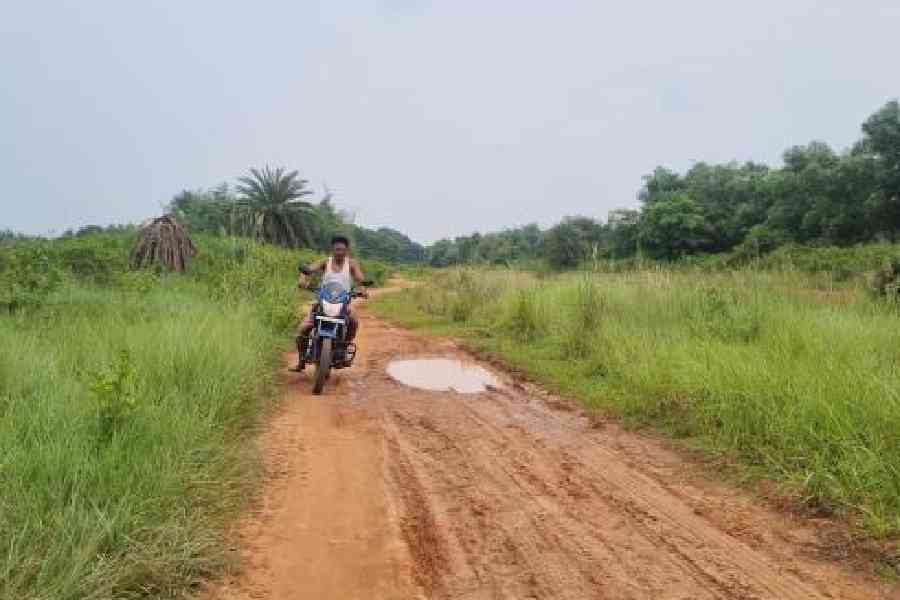Khokan Khilari was riding his new motorbike on a bumpy and slushy red-soil road that cut across the dense Brindabanpur forest of Jhargram.
Although Khilari was balancing himself on the zigzag laterite road, his eyes were fixed more on the forest than the path.
Why?
“If I fall on the road, my face will just be red with this moram slush. But if I fail to spot an elephant and it chases me — well, you know what the outcome would be,” said Khilari, a farm labourer who rarely takes out his motorbike.
“Look at the condition of this road. If an elephant chases you, you can’t even escape on your bike here. That’s why I was cautious, tracking whether there was any elephant ahead,” he added.
Although elephants usually emerge from the forest after dusk, spotting one in broad daylight is not rare.
The 36-year-old father of two claimed that if he could spot the animal from a good distance, he could turn his bike around and retreat. “That’s why we are always more careful in the forest than on the roads — even though the roads themselves are in bad condition,” he explained.
“Do you know how many elephants are here? More than 20. If one of them chases me, I can’t even ride fast because of the road’s condition,” said Khilari from Guripukur village, around 8km from Jhargram town.
The laterite road of around 2km connects Andharisole to Brindabanpur through the forest and is used by the residents of at least three tribal hamlets as a shortcut to the district headquarters of Jhargram. For most urban and rural areas of Bengal, bad roads filled with potholes are a challenge. But in Jhargram’s rural hamlets, the challenge multiplies because of elephants.
In the past decade, the number of elephants has risen significantly.Seventy-year-old Sahebram Hansda, travelling to Jhargram by bicycle, said that until 20 years ago, meeting an elephant was considered lucky. “Now, you can encounter an elephant any time,” said the septuagenarian, before warning that the road should be used with care.
In Kajla, villagers have surrounded their homes with iron wire and tied small pieces of polythene packets to it. The wind makes the polythene rustle, creating noise. “Elephants pass along our village road every night, sometimes in groups of 20 or 30. Even without electricity, the elephants think the wire is electrified, especially because of the noise from the polythene in the wind. We also use this method to protect our crops from elephants,” said Sundar Hansda, a resident of Kajla village.
“You’re asking about the road condition? Here, we’ve left the road for elephants to save our lives and livelihoods,” he added.
As elephant numbers have increased in the western districts, human-animal conflict has also grown in Jhargram.

An elephant beside the forest road in Jhargram. Picture by Sudipta Mitra
According to forest department sources, in the financial years 2022–23 and 2023–24, a total of 26 and 17 people, respectively, were killed in human-elephant conflicts in Jhargram. In 2024–25, the number dropped to six.
“Although the number of elephants increased, we were able to reduce deaths thanks to continuous surveillance of elephant movements. By placing our teams at strategic locations, we could warn people and save lives,” said Jhargram divisional forest officer Umar Imam.
Bad road conditions are also a major challenge in other Jungle Mahal districts — Purulia, Bankura and West Midnapore.
Amid the threat of frequent human-animal conflicts, villagers want all connecting roads to be paved so they can reach towns faster and escape if chased by animals. However, senior officials say constructing concrete roads inside forest zones, especially in elephant habitats, is not easy.
A senior forest officer explained: “We don’t want too many paved roads inside the forest. If there’s a metal road, vehicles will travel faster and may fail to spot animals crossing. This could increase accidents and deaths.”
So, the crucial question remains — how to balance road safety and human-elephant conflict prevention without compromising either?
“It’s better to maintain the laterite roads continuously, rather than paving them, in areas passing through the forest,” said the forester.

